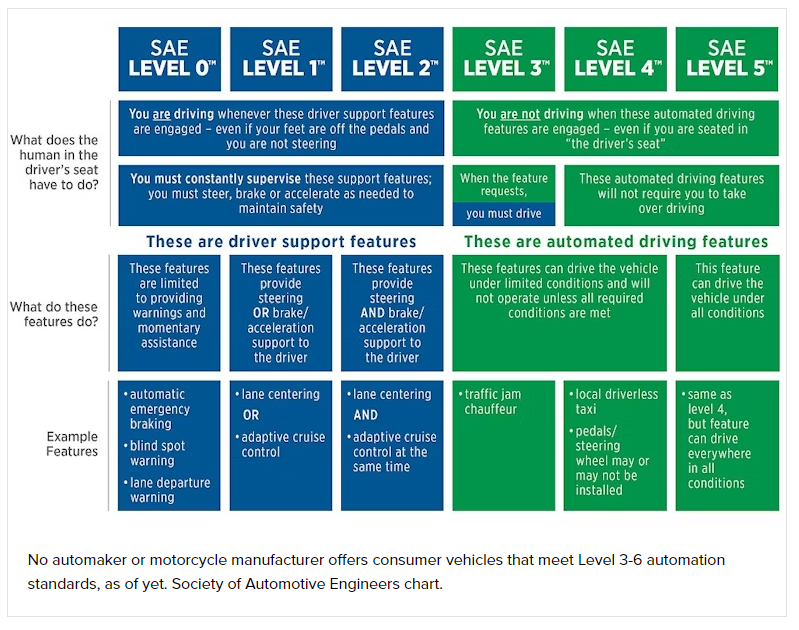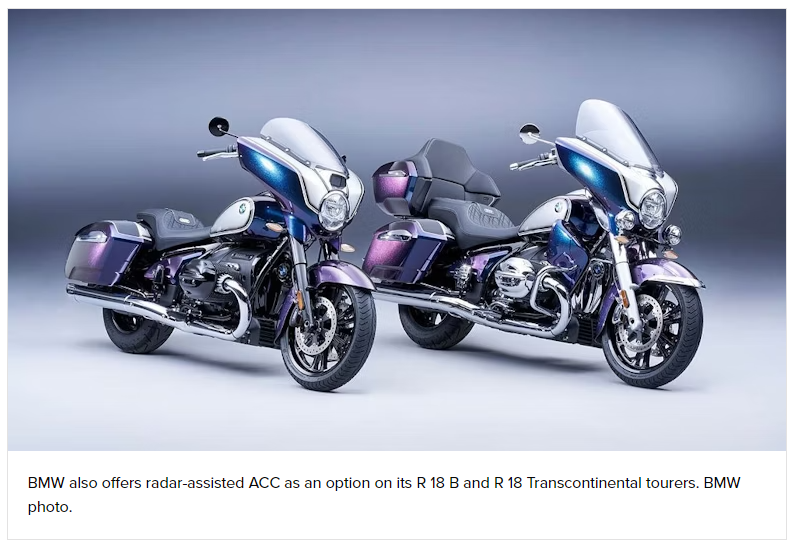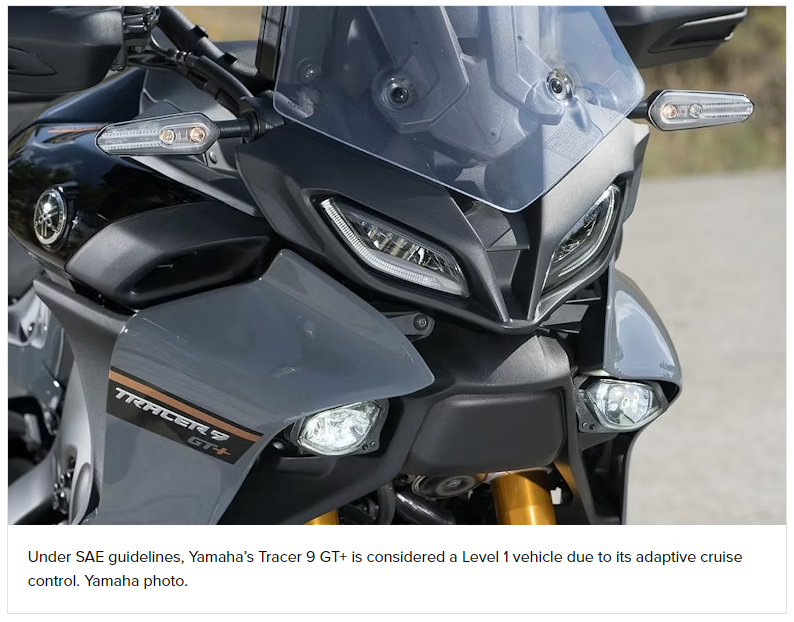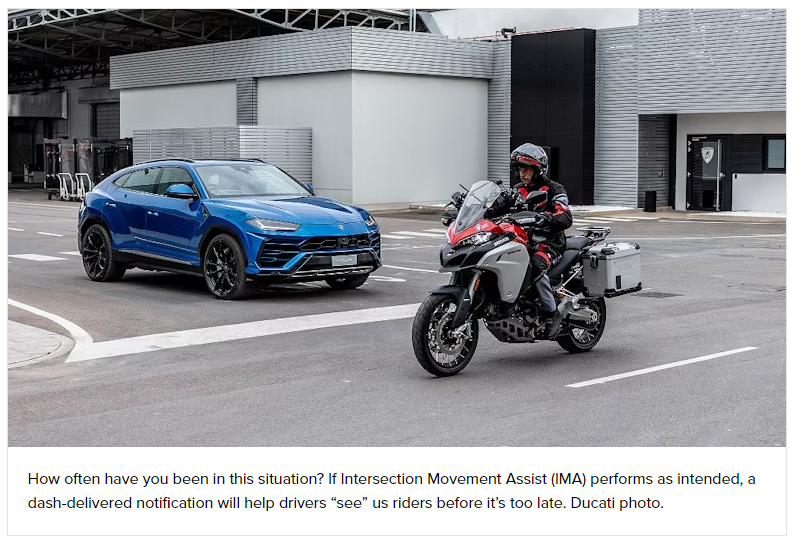The current state of Advanced Rider-Assistance Systems (ARAS)
For decades, self-driving vehicles were mere concepts of science fiction. With today’s Advanced Driver-Assistance Systems (ADAS) offering autonomous aids like lane-centering and adaptive cruise control, science fiction is quickly becoming a reality. Many of these features are now trickling down to modern motorcycles and helping to shape emerging Advanced Rider-Assistance Systems (ARAS).
By Dustin Wheelen Courtesy Revzilla
Some of the most extreme examples of ARAS come from electric motorcycle startups like Damon and Verge. Both brands are promising long-range radar units along with front- and rear-facing cameras that scan the roadway for hazards. When either system detects a potential threat, it sends a notification to the vehicle’s TFT dash, allowing the user to take evasive action.

Damon claims that its Copilot advanced warning system also relays haptic feedback through the handlebars and illuminates two windscreen-embedded LEDs when it identifies on-road dangers. So far, however, the company has not begun production and moved beyond the demonstration phase. Damon illustration.
While electric moto-makers advertise the safety gained from “360-degree awareness” and AI-based algorithms, it’s important to note that none of these camera-aided systems are currently on the road. That leaves Damon and Verge still in the realm of theoretical rider systems that largely imitate existing driver systems. That doesn’t mean that ARAS aren’t already available on current production models. They’re just offered in various degrees of complexity and sophistication.
Levels of automation
The Society of Automotive Engineers (SAE) is responsible for classifying driving automation into six categories. Level 0 vehicles primarily deliver notifications to the operator (lane departure warning), whereas systems that automate acceleration and deceleration (adaptive cruise control) or steering (lane centering) qualify as Level 1. Systems that simultaneously automate both steering and acceleration and deceleration meet the grade for Level 2.

The most advanced automobile systems on the road today offer Level 2 automation. Notable examples include Tesla’s Autopilot and Ford’s BlueCruise. Motorcycle manufacturers have yet to relinquish steering responsibilities to the machines (thankfully so). Therefore, bikes monitored by ARAS slot into either Level 0 or Level 1 automation. OEMs achieve these ratings with a diverse assortment of hardware and software.
Ducati introduced the first motorcycle equipped with adaptive cruise control (ACC) and blind-spot detection (BSD) with the 2021 Multistrada V4 S. Developed in partnership with Bosch, the systems utilize radar units fore and aft. Regulating ACC's following distance, the front-facing sensor measures the distance to the preceding vehicle. The rear-facing device recognizes objects in the rider’s blind spots and relays a warning via lights mounted atop the sideview mirrors. Bosch also developed Level 1 applications for the KTM 1290 Super Adventure S, but another adventure-tourer takes a simpler approach.

When Triumph refreshed its Tiger 1200 range in 2022, the top-spec GT Explorer and Rally Explorer variants earned a rear radar device. Both bikes gained BSD as a result, but the Hinckley designers passed on a front-facing unit — and ACC along with it. By only delivering warnings to the rider, the range-topping Tigers fall into the Level 0 category. Still, other ARAS configurations exist.
Take the Yamaha Tracer 9 GT+, for example. Yamaha’s crossover adopted a front radar unit in 2024 but forewent a rear-facing sensor and the accompanying BSD. Similar to the Multistrada V4 S, the Tracer’s fairing-mounted radar unlocks ACC but it also drives the tourer’s new Unified Braking System (UBS).

The linked braking system measures the vehicle’s current closing speed by drawing data from the front radar and six-axis IMU. When UBS determines that the braking pressure applied is insufficient to avoid a front-end collision, it applies additional stopping power. Yamaha stresses that UBS isn’t a collision-avoidance system, but it’s the closest thing the motorcycle industry currently offers.
![]()
As of now, radar-based warning systems and automated aids only come on top-tier models. The 2024 Tracer 9 GT+ is the most affordable option of the bunch at $16,499. Other ARAS-equipped bikes like KTM’s 1290 Super Adventure S ($20,999), Triumph’s Tiger 1200 GT Explorer ($23,595), Ducati’s Multistrada V4 S ($27,195), and Kawasaki’s Ninja H2 SX SE ($28,000) don't go as easy on the wallet.
Many brands develop and promote automated rider aids to improve motorcycling safety, and in turn, draw in new riders. But that’s the crux of the matter. The costs associated with developing such technologies only increase retail prices. That does little to grow the sport. For now, customers pay a premium for the safety and convenience that ARAS provide. And yet, motorcycles only stand to get more complicated in the coming years.
![]()
Communication is key
The Connected Motorcycle Consortium (CMC) dates back to 2015 and currently includes BMW, Honda, Yamaha, Ducati, KTM, and Suzuki. The collaborative alliance aims to enhance rider safety by developing connective technologies — namely, vehicle-to-vehicle (V2V) systems. For the uninitiated, V2V enables two vehicles, and their different systems, to communicate on the road. When that interaction is between a motorcycle and car, V2V systems offer new warning systems for both parties.
In September, Ducati showcased a new V2V prototype at the CMC’s Demo Event in Germany. Operating a Multistrada 1260 and a Lamborghini Urus, the team demonstrated three warning systems made possible by the car-to-motorbike communication system.
- Intersection Movement Assist (IMA): Alerts a car driver to the presence of a nearby motorcycle when both vehicles approach an intersection perpendicularly. The feature is especially useful when the driver’s visibility is limited or obstructed.
- Left Turn Assist (LTA): Active only when a motorcycle and car approach an intersection from opposite directions, this feature sends a warning message to both the driver and rider when the driver activates their left turn signal at an intersection.
- Do Not Pass Warning (DNPW): In this scenario, the motorcycle trails several vehicles behind a turning car. Should the turning car have a V2V system, the rider will receive a warning not to overtake as soon as the driver activates the car’s blinker.
I know what the skeptics out there are thinking (because I count myself among them): That’s putting a lot of trust in drivers to actually use their turn signals. Even so, I have to admit that any system successful at alerting motorists (especially distracted ones) to the presence of a motorcyclist would be appreciated.

Despite presenting V2V applications, neither Ducati nor the CMC revealed any immediate plans for the technology. We can count on one thing, though. V2V technologies will continue to evolve. ARAS features may draw heavily from ADAS development, but connecting the differing systems (automated or not) will be the next frontier of safety-oriented assistance systems.
SOURCE: Revzilla
Disclaimer:
As a service to the sport we all love and follow, Biker Life posts numerous media releases from a wide variety of sources on our website. Due to the large number, and sometimes short time available, it is nearly impossible to review each public release. These articles are written by reporters, writers or press officers who work for various organizations, event organizers, teams, drivers, riders, and other parties, and they do not necessarily reflect the opinions of Biker Life.